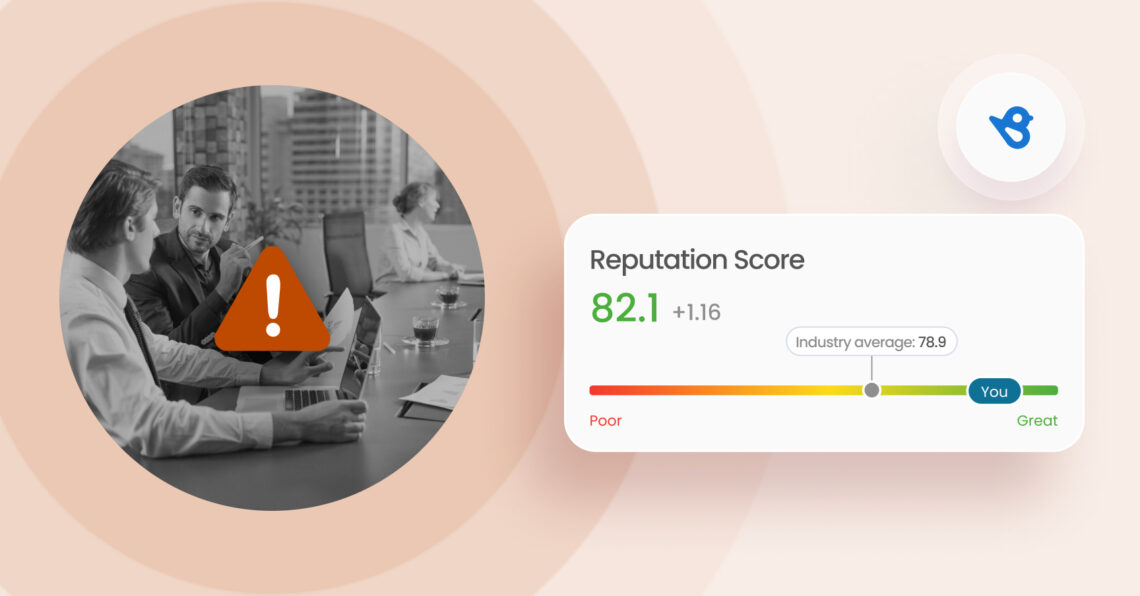When a crisis hits, brand crisis management becomes critical to protecting your reputation, customer trust, and long-term success. Whether you’re a global brand or a growing startup, how you respond can determine whether you recover—or lose credibility permanently.
This is where a clear, proactive crisis strategy comes in. This blog will walk you through the fundamentals of brand crisis management, including real-world examples, actionable steps, and best practices to help your team respond with confidence.
Table of contents
- What is brand crisis management?
- Successful brand crisis management examples
- Poor crisis management examples
- What are the stages of brand crisis management
- 6 steps to respond to a brand crisis effectively
- Best practices for brand crisis management in 2025
- Lessons learned
- Social media during a brand crisis: What to do first
- Frequently asked questions on brand crisis management
- How Birdeye helps brands manage their online reputation management
What is brand crisis management?
Brand crisis management is a systematic approach businesses use to anticipate, respond, and recover from unexpected events that could threaten their operations, reputation, or public perception.
The goal is to minimize the impact of the crisis while ensuring business continuity and protecting customer trust.
Types of brand crises
Businesses can face many types of crises, and recognizing the category helps determine how to respond. Here are some of the most common:
- Product or service failures: Product recalls, service outages, or quality issues that impact customer satisfaction and safety.
- Social media backlash: Viral posts, insensitive tweets, or online criticism that spreads rapidly and damages your brand.
- Reputational scandals: Misconduct, unethical leadership behavior, or workplace culture issues that erode public trust.
- Legal or regulatory crises: Lawsuits, government investigations, or compliance violations that impact brand credibility and finances.
- Cybersecurity or tech failures: Data breaches, system outages, or technical failures that compromise operations and customer trust.
- Financial crises: Revenue loss, cash flow issues, investor fallout, or financial mismanagement that threatens business survival.
- Supply chain disruptions: Vendor issues, logistical breakdowns, or raw material shortages that delay or halt operations.
Now that we’ve identified the types of crises your brand might face, let’s break down what effective crisis management looks like.
Successful brand crisis management examples
Effective crisis management requires clear, timely communication and a proactive approach. These successful crisis management examples show how well-known brands handled challenging situations with precision, transparency, and accountability.
Johnson & Johnson (Tylenol crisis)
In 1982, Johnson & Johnson faced a crisis when several people died after taking Tylenol capsules laced with cyanide. Here’s how they responded: The company immediately recalled 31 million bottles of Tylenol and communicated openly with the public, putting customer safety first.
This approach of transparency, quick action, and putting public health ahead of profit helped the company recover and restore customer trust. Today, the Tylenol crisis is often cited as one of the best examples of brand crisis management.
Pepsi (syringe incident)
In 1993, Pepsi faced a crisis when a hoax claimed that syringes were found in their cans. Here’s how Pepsi acted: The company swiftly launched a media campaign to demonstrate its quality control processes and prove that individuals had planted the syringes, which were not part of the manufacturing process.
Their transparent and immediate response helped protect the brand’s image, and they even received praise for handling the situation.
Southwest Airlines (holiday travel crisis)
During the 2022 holiday season, Southwest Airlines faced widespread flight cancellations that stranded thousands of passengers. Here’s how Southwest handled it: The airline apologized publicly, took full responsibility for the chaos, and promised to fix the operational issues that led to the cancellations.
Though the crisis was painful, their acknowledgment of the problem and ongoing communication with affected customers helped them manage the situation and maintain their customer base in the long run.
Starbucks (racial profiling incident)
In 2018, two Black men were arrested at a Starbucks location in Philadelphia after being accused of loitering. Here’s how Starbucks responded: The company quickly apologized, announced a national day of employee sensitivity training, and vowed to take steps to ensure such future incidents did not happen again.
Starbucks’ swift and empathetic approach helped the company recover, and its focus on addressing systemic issues within its stores improved its public image.
Cracker Barrel (anti-LGBTQ+ crisis)
In the 1990s, Cracker Barrel faced backlash for firing employees who were openly gay. Here’s how Cracker Barrel acted: Over time, they changed their policies, offering apologies and implementing inclusivity initiatives aligned with broader social changes.
The company’s shift toward inclusivity helped rebuild its reputation among LGBTQ+ communities and others concerned with corporate social responsibility.
Ford (Firestone tire recall)
In 2000, Ford faced a crisis when defective Firestone tires caused fatal accidents in Ford Explorers. Here’s how Ford responded: The company worked closely with Firestone to recall the tires, proactively communicating with the public and taking responsibility for the defective products.
Their timely and responsible actions helped mitigate the damage to their reputation and restored consumer trust in the Ford brand.
The Virgin Group (customer service failures)
The Virgin Group faced multiple crises concerning poor customer service, especially in their airline and train services. Here’s how they acted: CEO Richard Branson personally apologized to customers and got involved in improving the customer experience. Branson’s direct involvement reassured customers that the company was taking steps to fix the issues.
This hands-on approach helped the Virgin Group maintain customer loyalty and recover from the service-related crisis.
KFC (chicken shortage crisis)
In 2018, KFC experienced a chicken shortage in the UK that led to the closure of many of their stores. Here’s how KFC handled it: They took a humorous approach by putting up a sign in front of their stores that read “FCK” instead of KFC, making light of the situation.
Their sense of humor and transparency helped maintain customer goodwill, showing that sometimes a lighthearted approach can go a long way in managing a crisis.
Poor crisis management examples
While some companies excel in crisis management, others fall short, and the results can be disastrous. Here’s a look at some brands that struggled to handle crises:
United Airlines (passenger removal incident)
In 2017, United Airlines made headlines for forcibly removing a passenger from an overbooked flight. Here’s how they mishandled it: The company initially responded poorly, with the CEO offering a weak apology and downplaying the incident. Their failure to quickly address the public’s outrage only made things worse.
United’s poor communication and lack of a swift resolution damaged their reputation for a long time.
Uber (sexual harassment scandal)
Uber’s internal culture came under fire in 2017 after multiple allegations of sexual harassment and a toxic workplace environment. Here’s how Uber mishandled the situation: The company’s initial response was lackluster, and it took too long for them to address the deeper issues within their corporate culture.
Uber’s delayed and ineffective response contributed to a significant public relations disaster, leading to a series of leadership changes and ongoing damage to its reputation.
Chipotle (food safety crisis)
In 2015, Chipotle faced multiple E. coli outbreaks linked to its food, leading to public health concerns. Here’s how Chipotle responded: Initially, the company struggled to communicate effectively and assure customers that their food was safe. It wasn’t until the crisis had escalated that they took full responsibility and began implementing better food safety measures.
While they eventually recovered, their slow response hurt their brand long-term and led to a decline in sales.
Volkswagen (emissions scandal)
In 2015, Volkswagen was caught cheating on emissions tests, leading to a massive scandal. Here’s how Volkswagen mishandled it: The company initially denied the allegations and attempted to cover up the scandal. Their lack of transparency and failure to address the issue directly led to a significant loss in consumer trust and a prolonged crisis.
The scandal had long-term consequences for Volkswagen’s reputation and financial stability.
In this age of fast communication, your response window is shorter than ever. Let’s take a look at how to structure your crisis response from start to finish.
What are the stages of brand crisis management
Effective crisis management involves a series of strategic actions, each critical for a brand’s ability to navigate and recover from a crisis. These stages ensure that brands can minimize damage and emerge stronger.
- Pre-crisis: The pre-crisis stage is about proactive planning and risk assessment. Brands identify potential threats, create contingency plans, and train key stakeholders to respond swiftly. The goal is to prevent or minimize crises by staying alert to emerging issues, monitoring industry trends, and establishing early warning systems.
- Crisis response: Quick, transparent, and empathetic action is essential. The crisis response phase requires brands to activate their crisis communication plan, provide consistent updates, and engage with impacted stakeholders. A clear, calm, and measured response helps maintain brand reputation and control the narrative while addressing immediate concerns.
- Post-crisis: Post-crisis management focuses on recovery and growth. After the crisis subsides, brands assess the effectiveness of their response, rebuild trust, and communicate lessons learned to stakeholders. This stage also involves refining future strategies and making improvements to prevent similar issues from arising, ensuring long-term resilience.
Now that you understand the stages of managing a crisis, here’s a step-by-step framework to help your team take action when a crisis hits.
Understanding Brand Crisis Management
Want to see the impact of Birdeye on your business? Watch the Free Demo Now.
6 steps to respond to a brand crisis effectively
A clear, step-by-step response plan can help teams act fast and stay aligned during a brand crisis. Here’s a simple framework to follow:
Step 1: Identify the crisis
Quickly define what happened, which channels are involved, and who’s affected (customers, employees, partners, press).
Step 2: Assemble your crisis team
Assign clear roles: Who is the spokesperson? Who monitors social media? Who handles legal, customer service, or press outreach?
Step 3: Activate your monitoring tools
Use social listening platforms, review monitoring, and alert systems to track mentions, sentiment, and keyword spikes in real time.
Step 4: Craft and align your message
Prepare your first public response, FAQs, and internal talking points. Keep the tone factual, empathetic, and aligned across all touchpoints.
Step 5: Respond and escalate where needed
Engage quickly and consistently. Use the appropriate channels—social, press, internal comms—and escalate legal issues as needed.
Step 6: Review, refine, and learn
After the crisis, assess what worked and what didn’t. Update your crisis playbook to improve future response.
Best practices for brand crisis management in 2025
Effective crisis management can make the difference between a brand’s image survival and its downfall. Here are some best practices to help businesses successfully prepare for and manage crises:
1. Form a crisis team
A dedicated crisis management team ensures that every aspect of the crisis is covered and decisions are made quickly. This team should comprise key personnel from different departments, such as PR, legal, operations, and leadership.
2. Assign a spokesperson
Having a single spokesperson ensures the messaging remains consistent throughout the crisis. This person should be trained to handle media inquiries and represent the company’s position clearly and confidently.
3. Act with honesty and integrity
Transparency is key during a crisis. Brands that act honestly and take responsibility for their actions are more likely to gain the trust of their customers and stakeholders.
4. Stay silent when appropriate
Not every situation requires immediate action or a public statement. Sometimes, waiting and gathering more information before responding is more beneficial. Silence can allow a company to make informed decisions and avoid escalating the situation.
5. Communicate the action plan
Once a company has identified its steps to address the crisis, it should communicate this clearly to the public. An effective crisis management plan can reassure customers that the situation is under control.
6. Consider rebranding
If a brand’s reputation has been severely damaged, rebranding can help distance the company from the crisis and signal that it is committed to change. Rebranding involves more than just changing the logo—it’s about a fundamental shift in how the company operates and communicates.
7. Use a visitor management system
In situations involving physical locations, a visitor management system can help track and manage customer flow, especially in crises. This can help ensure customer safety and maintain communication with visitors during the crisis.
Lessons learned
Crisis management is an essential skill for businesses of all sizes. Whether handling a product recall, managing a public relations disaster, or recovering from a scandal, how a company responds to a crisis plays a crucial role in its long-term survival.
By learning from the best—and worst—examples of crisis management, brands can prepare themselves for future challenges and recover more quickly.
Social media during a brand crisis: What to do first
Social media is often where a brand crisis starts—and where it spreads fastest. Having a social-specific crisis plan helps you respond quickly, protect your reputation, and control the narrative.
Here are a few must-dos during a social media crisis:
Pause scheduled content
Stop all pre-planned posts immediately. Automated content can appear tone-deaf during a crisis.
Monitor key platforms in real-time
Use social listening tools to track mentions, trending hashtags, and sentiment spikes. Set alerts for brand name variations and keywords tied to the issue.
Assign a dedicated social response lead
One person (or a small team) should handle all social media replies to ensure consistency, accuracy, and speed.
Use pre-approved holding statements
Draft short, clear responses in advance for crisis situations. This helps you acknowledge concerns while preparing a fuller response.
Don’t engage in arguments
Stay calm, factual, and polite—even when comments are emotional or unfair. Take heated discussions to private channels where possible.
Update frequently
Share updates on the situation as it evolves. Silence can be interpreted as avoidance.
Alongside social media, it’s equally important to understand how brand perception shifts across channels and how technology can help brands recover—especially in real time.
Frequently asked questions on brand crisis management
Brand crisis management is the process of handling unexpected events that threaten a company’s reputation. It aims to minimize damage and restore trust.
Effective crisis management helps protect a brand’s image, maintain customer sentiment and trust, and minimize the long-term impact of negative media coverage.
A company can prepare by creating an effective brand crisis management process, forming a crisis team, and using listening tools to monitor potential risks.
Clear, transparent, and timely communication is key to managing a crisis, ensuring that all stakeholders stay informed and the brand’s narrative is controlled.
A brand can restore trust by openly addressing concerns, offering solutions, and consistently demonstrating improvements in operations or values.
How Birdeye helps brands manage their online reputation management
Managing a brand’s online reputation is crucial, especially when dealing with crises. Birdeye, a platform for reputation management, helps businesses monitor, manage, and improve their online presence in real-time.
Here’s how Birdeye can help brands in crisis management and reputation recovery:
- Real-time monitoring: Birdeye provides businesses with tools to track customer feedback, reviews, and social media mentions across multiple platforms. This allows brands to avoid potential issues and address problems before they escalate into a larger crisis.
- Automated review collection: By automatically collecting customer reviews, Birdeye ensures businesses have up-to-date and genuine feedback. Positive reviews can help restore trust, while constructive criticism can be addressed quickly to show customers the brand is working to improve.
- Sentiment analysis: Birdeye’s sentiment analysis tools help brands understand public perception by analyzing the tone of customer feedback. This is especially helpful during a crisis, as it allows brands to understand how customers feel and adjust their responses accordingly.
- Review response: It is important to acknowledge and respond to customer concerns during a crisis. Birdeye makes it easy for brands to promptly, empathetically, and consistently reply to reviews and comments.
- Brand consistency across channels: Birdeye ensures that your brand’s messaging remains consistent across all customer touchpoints, which is crucial for maintaining trust during a crisis. Whether it’s through review responses, social media comments, or customer service interactions, Birdeye helps streamline your communication and crisis management efforts.
In short, Birdeye not only helps brands respond to crises but also helps them build long-term resilience by managing their reputation and staying connected with customers. By using Birdeye, brands can turn challenges into opportunities for growth and show their commitment to customer satisfaction.

Originally published


![[Feature image] Hotel review management](https://birdeye.com/blog/wp-content/uploads/Feature-image-Hotel-review-management-375x195.jpg)






